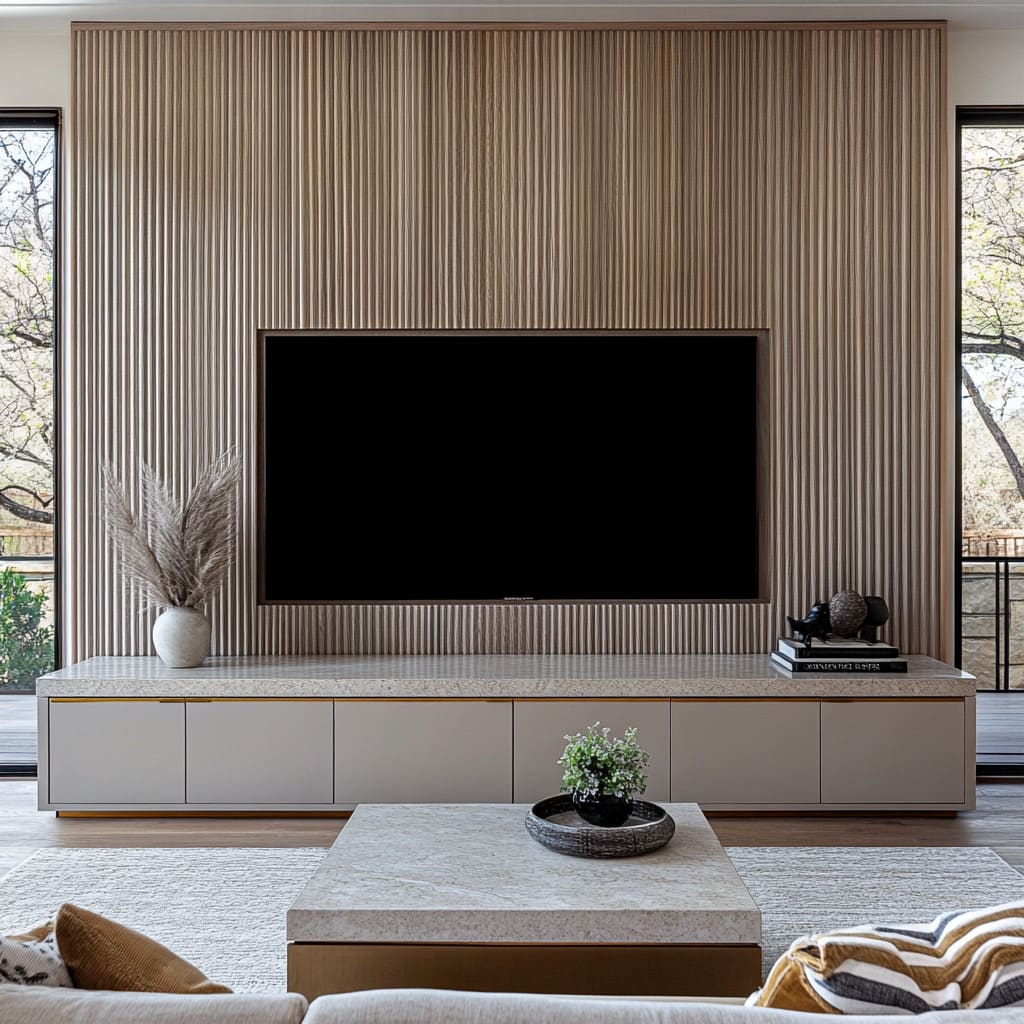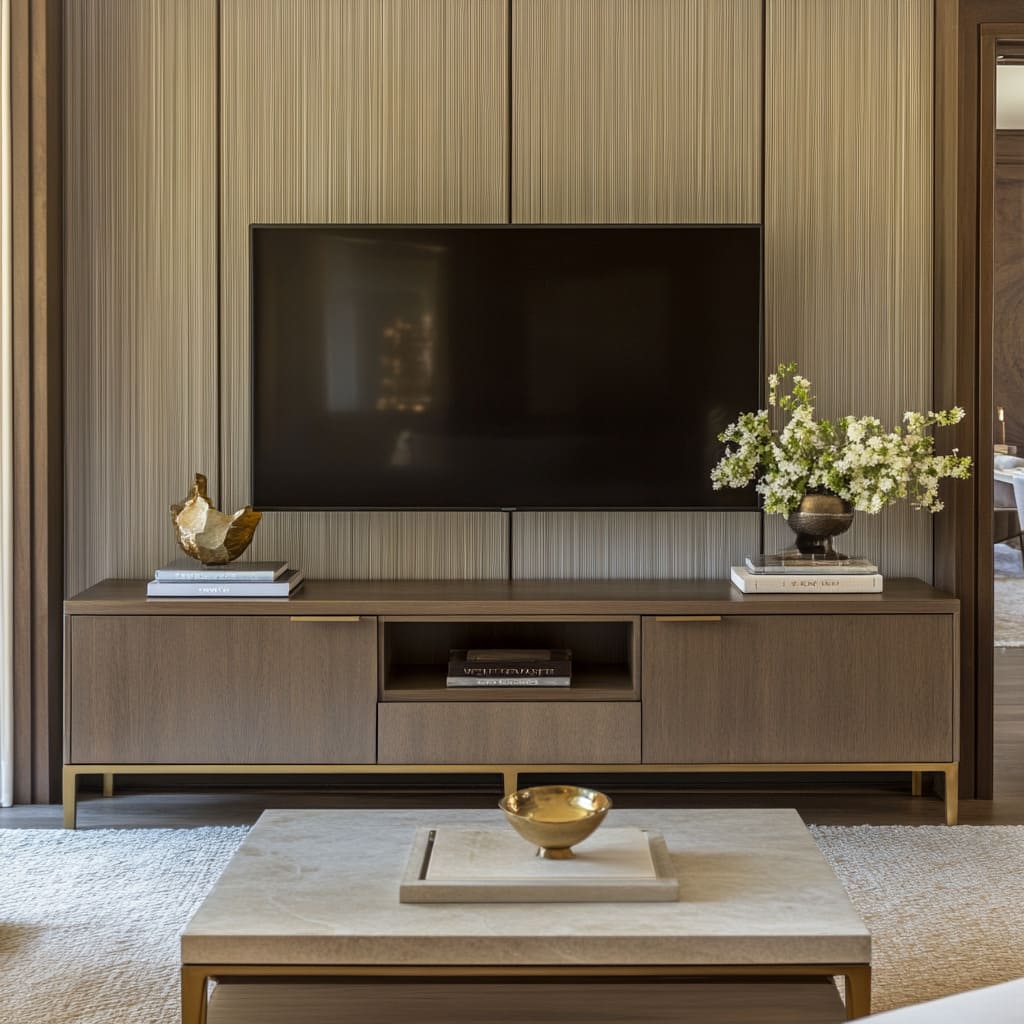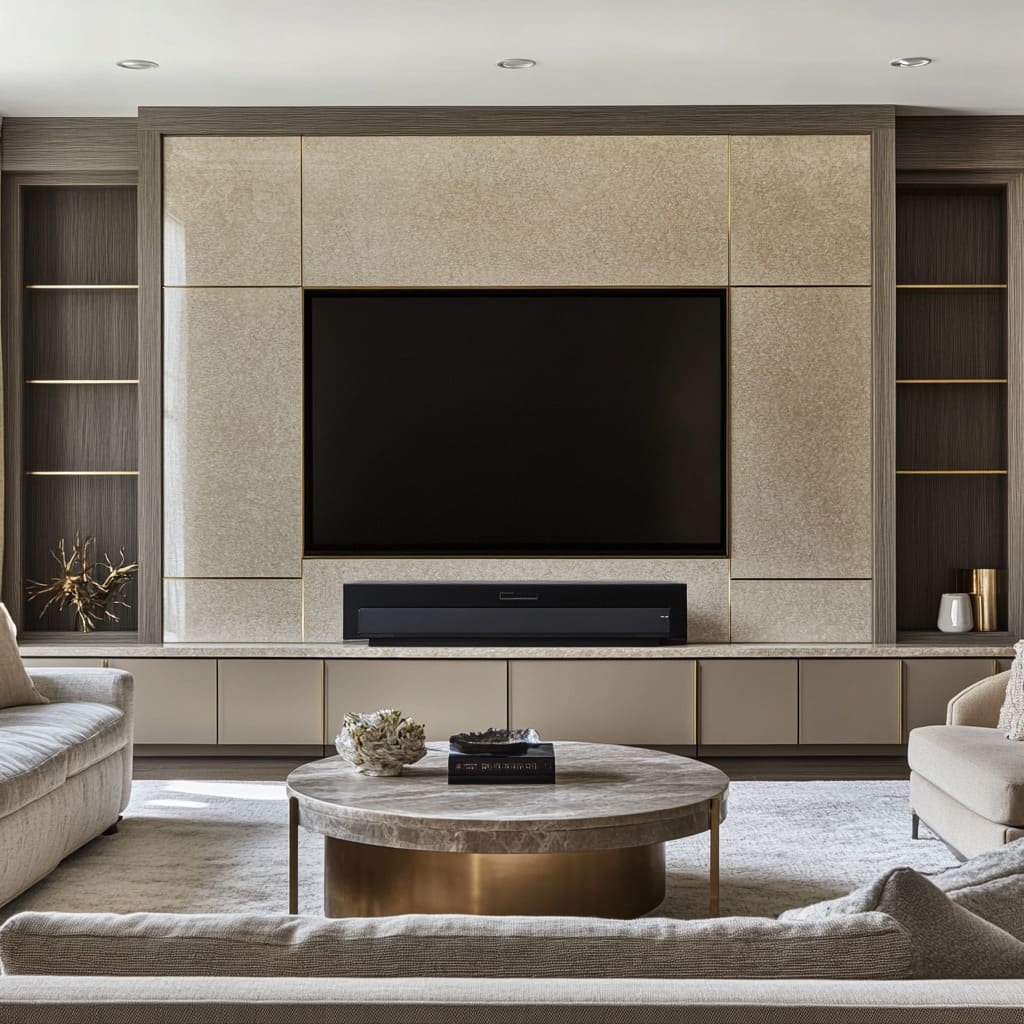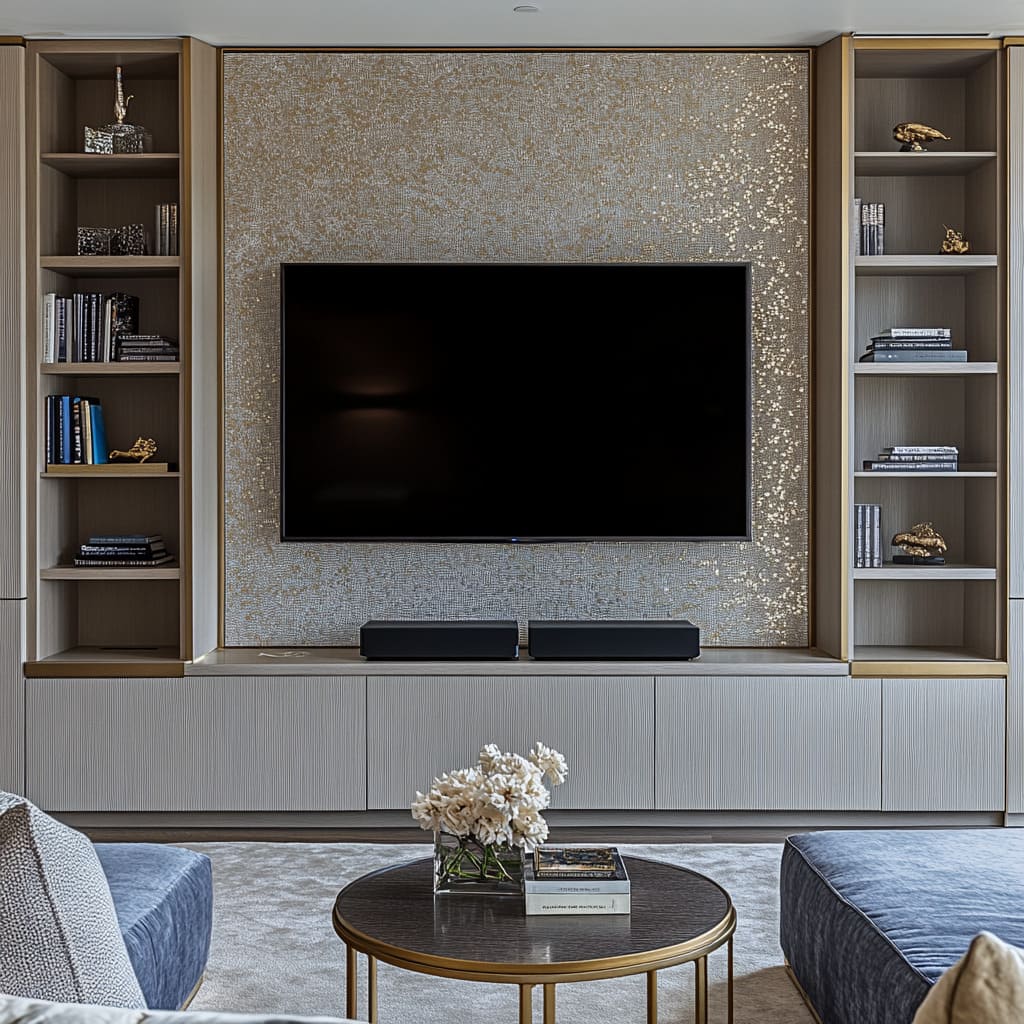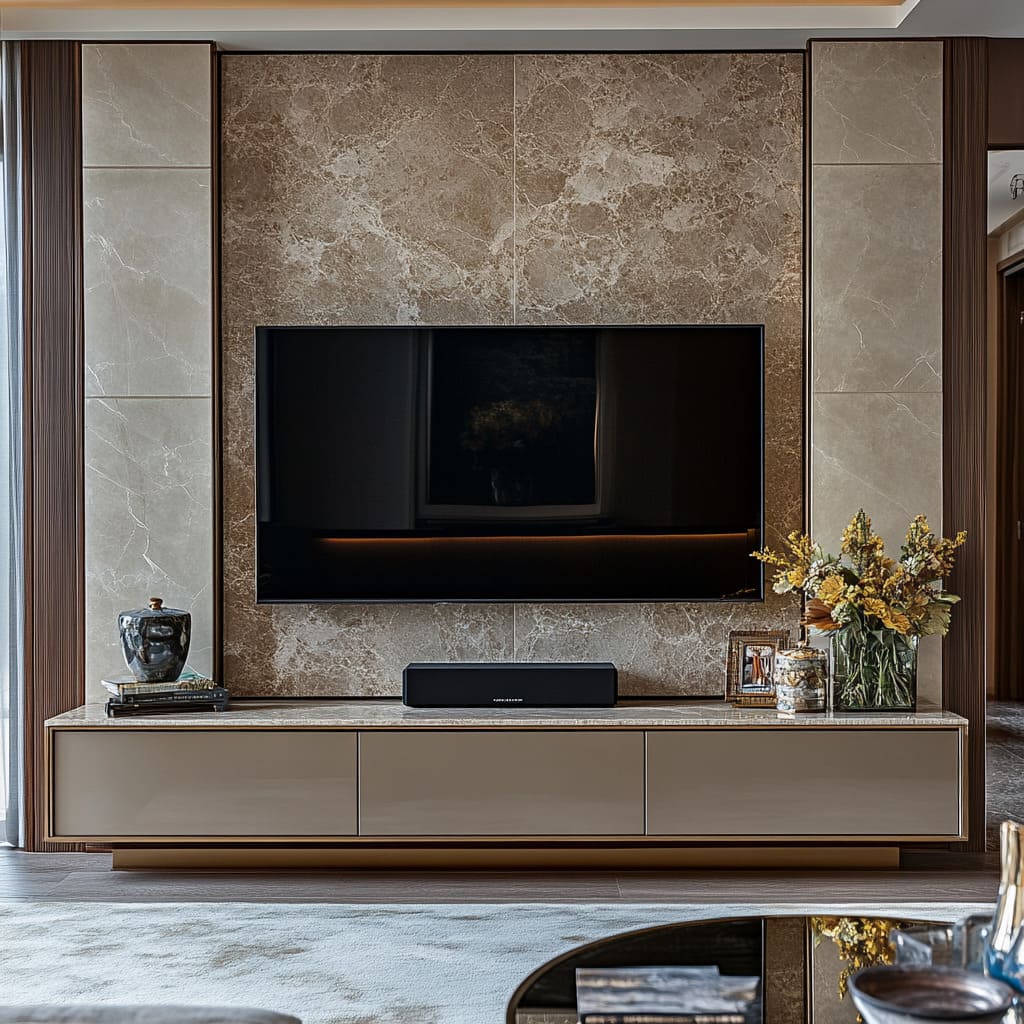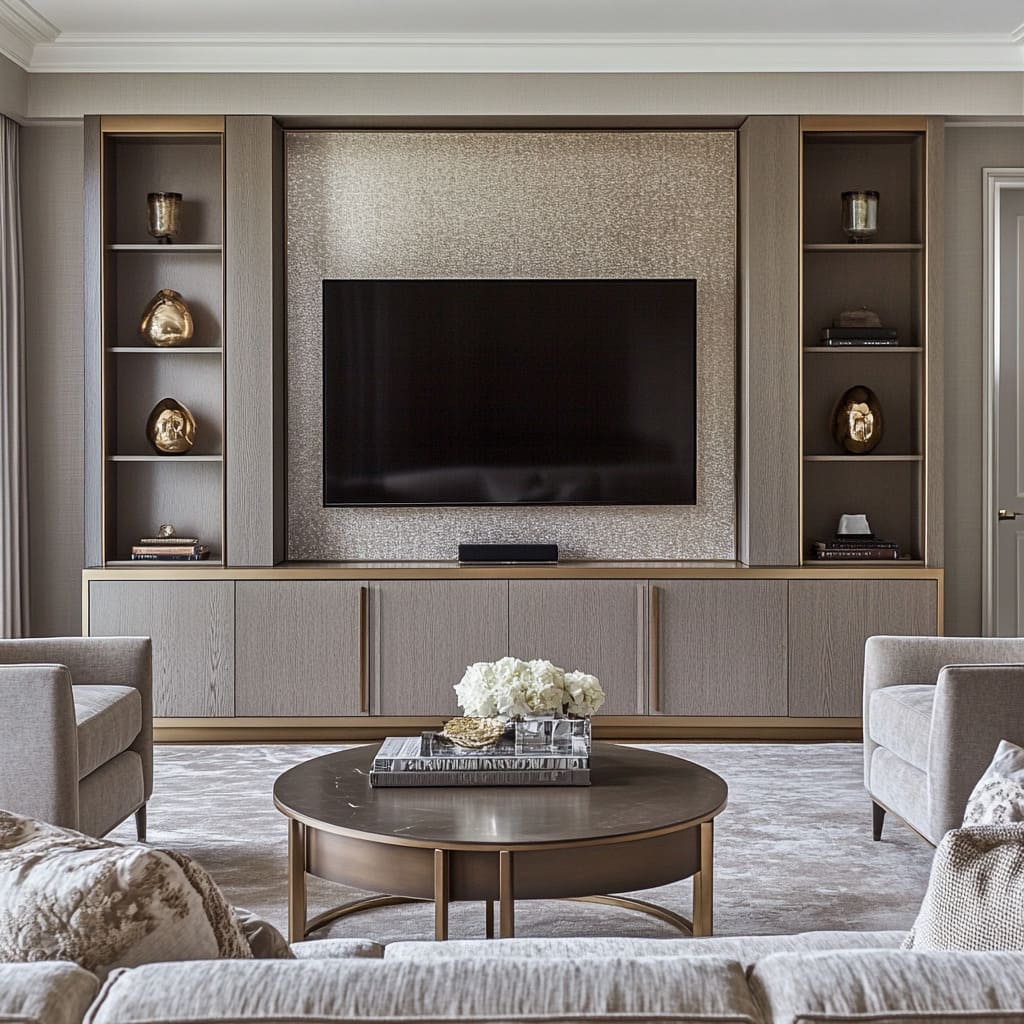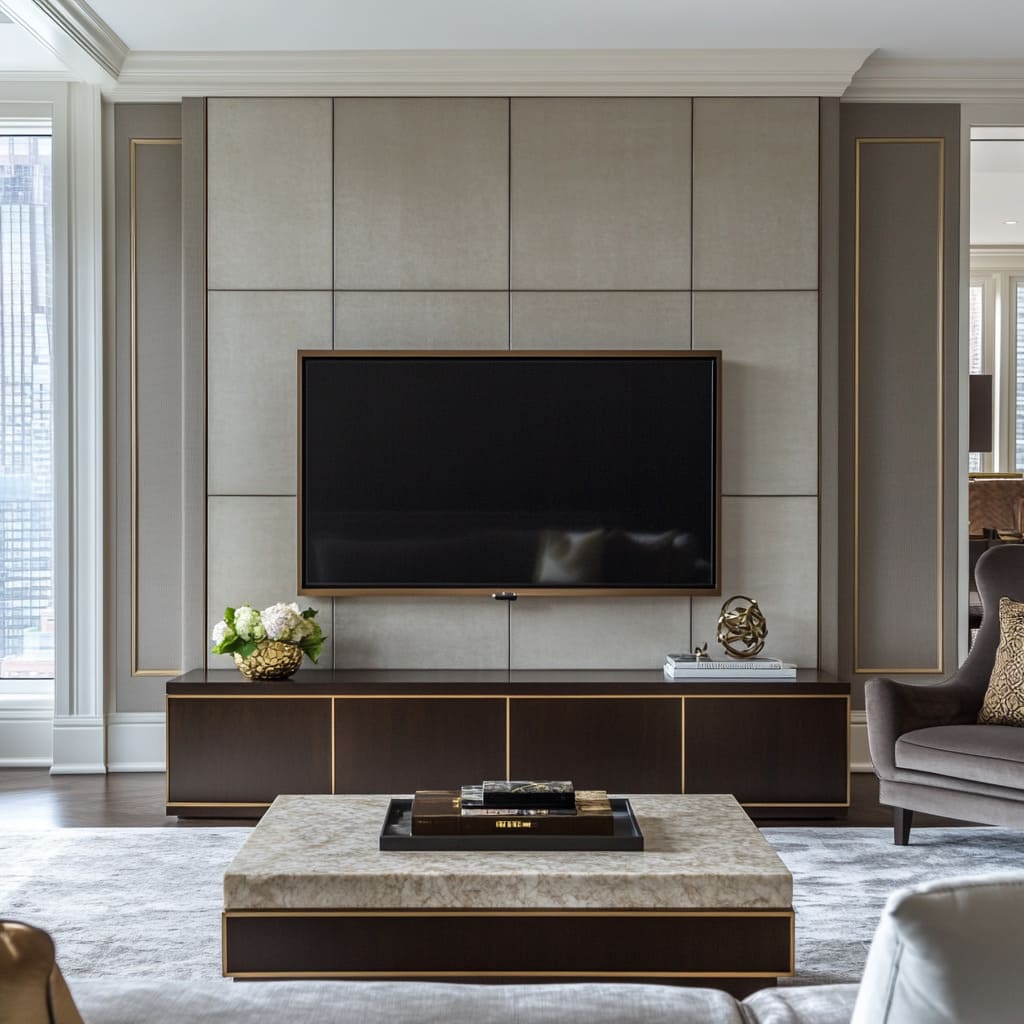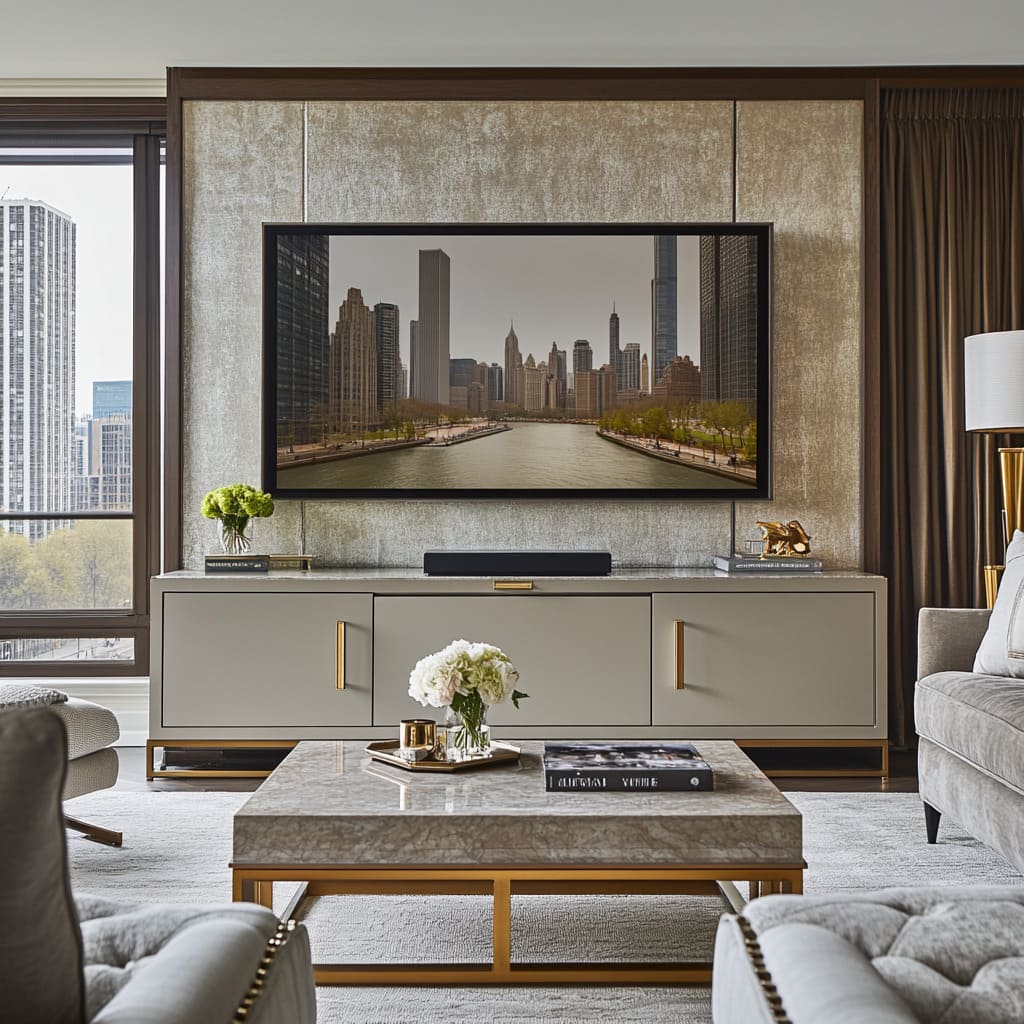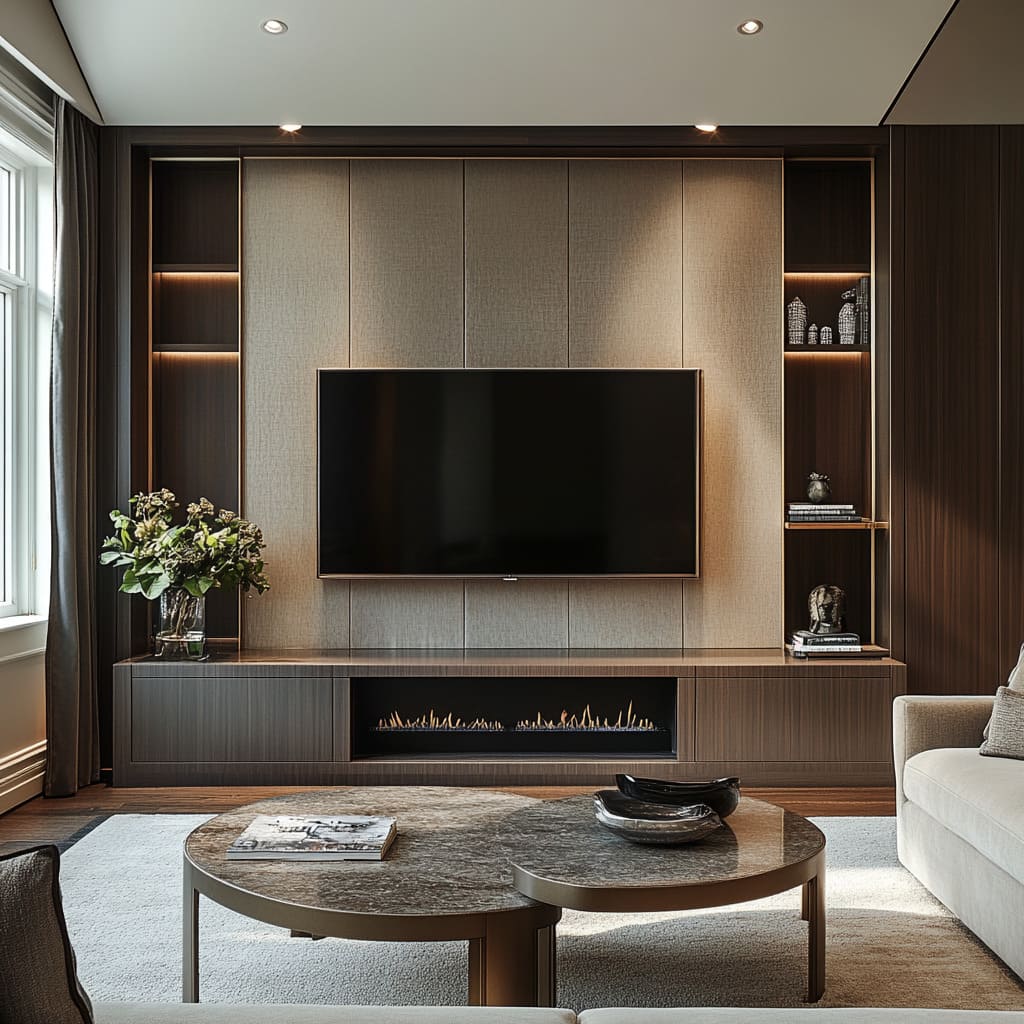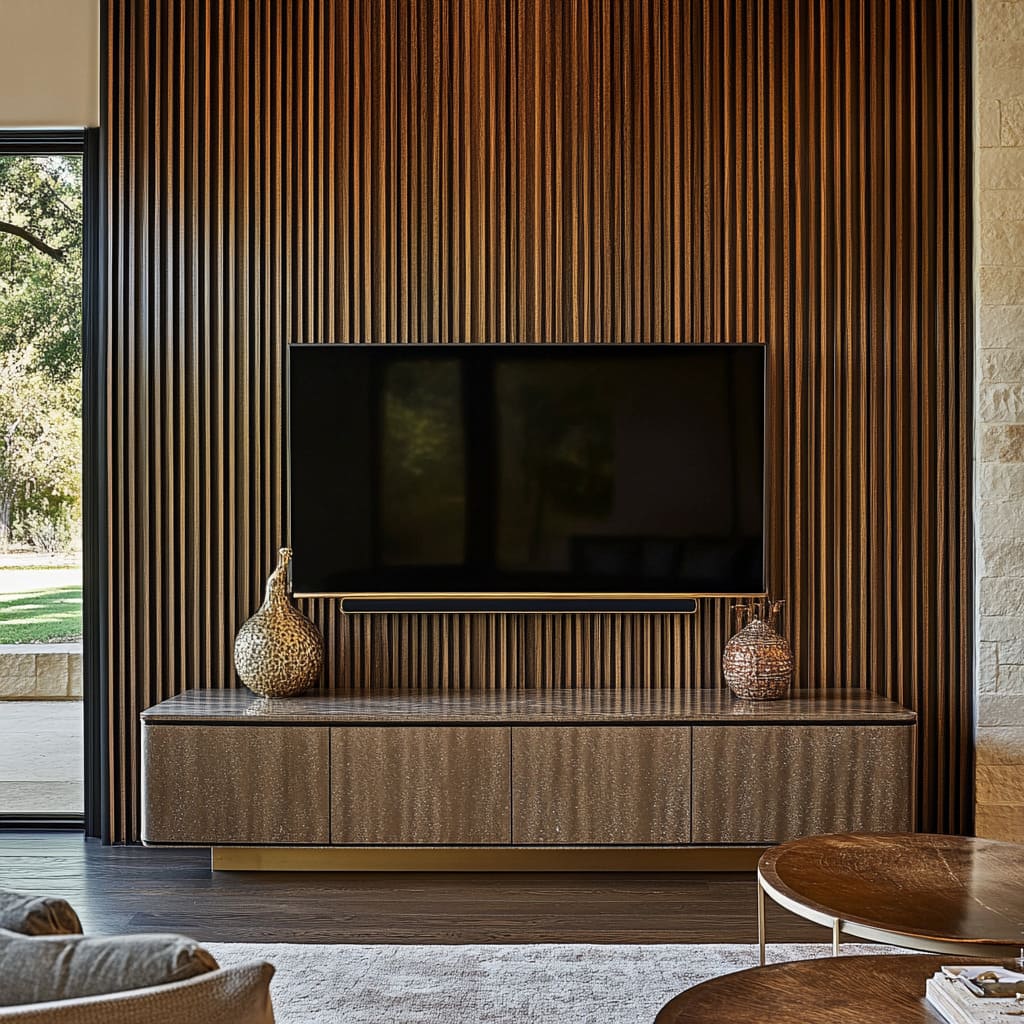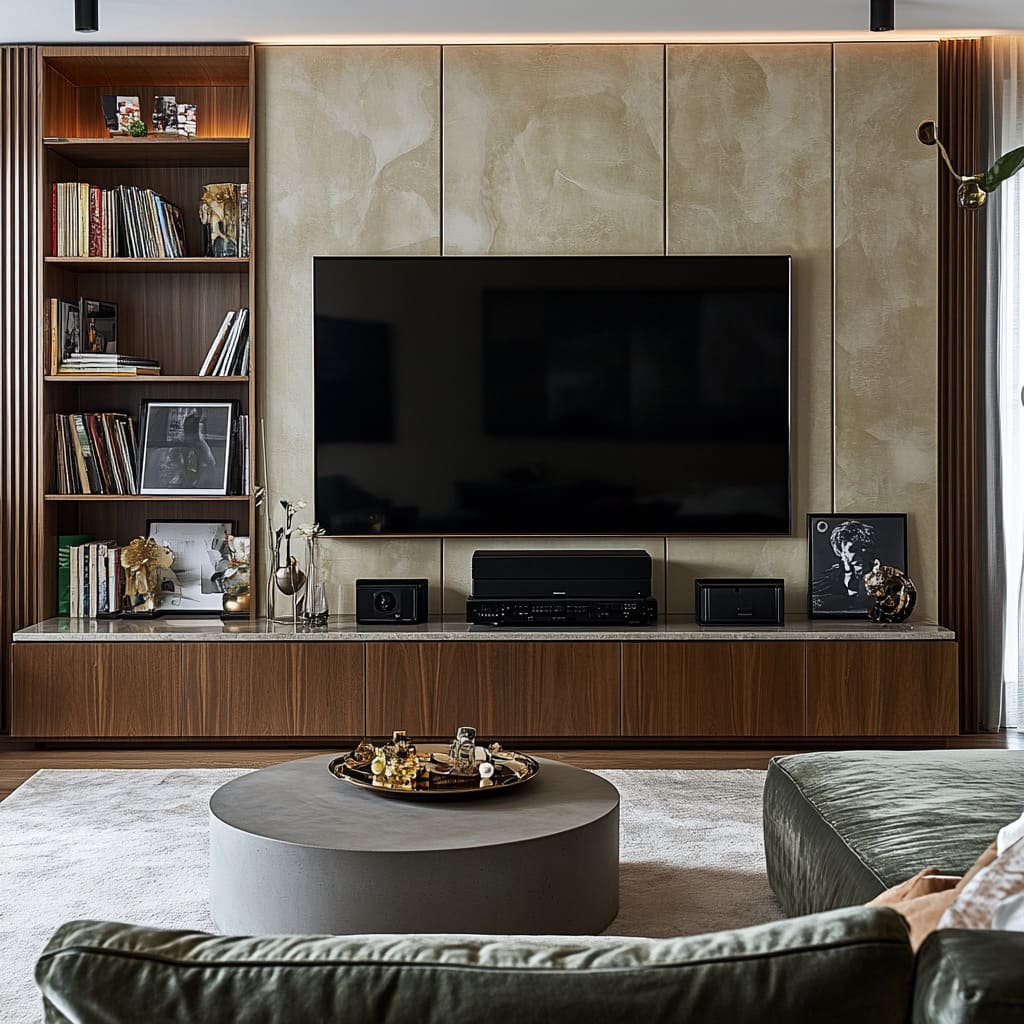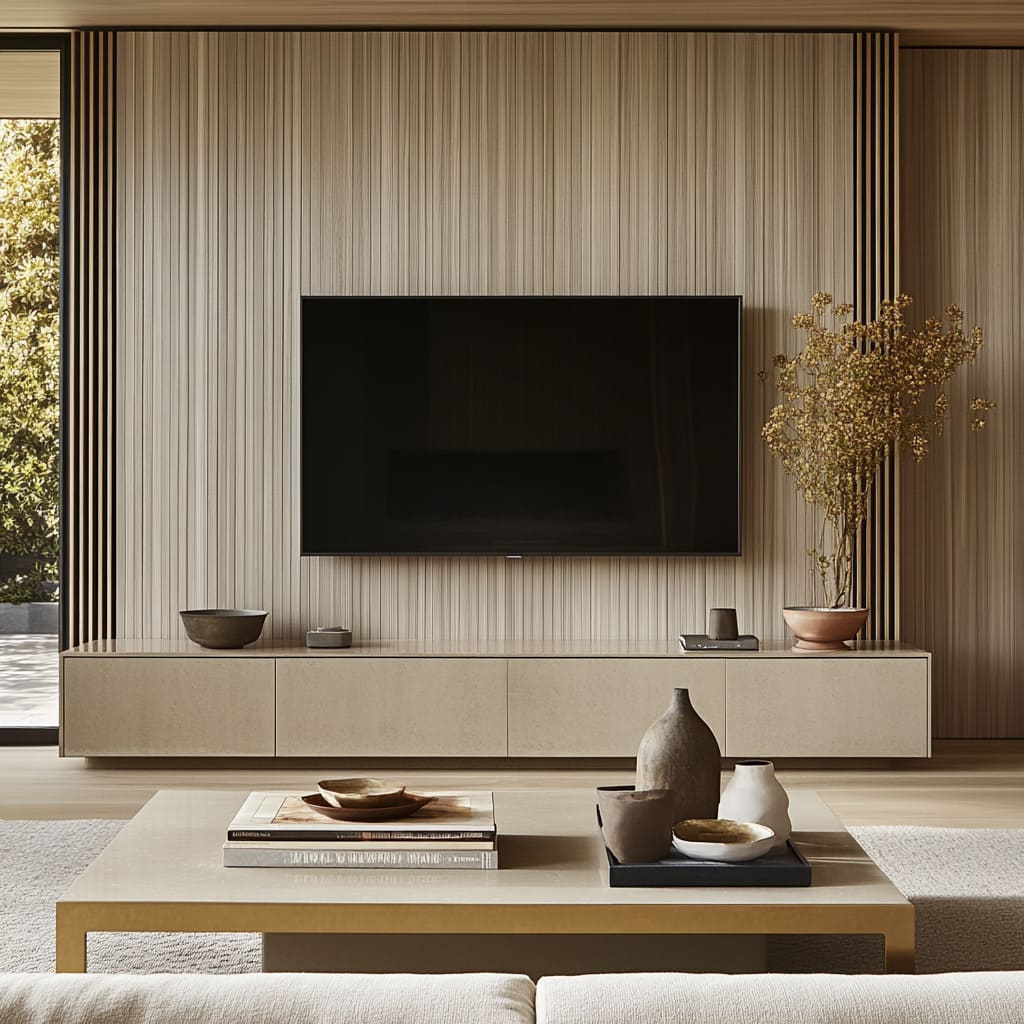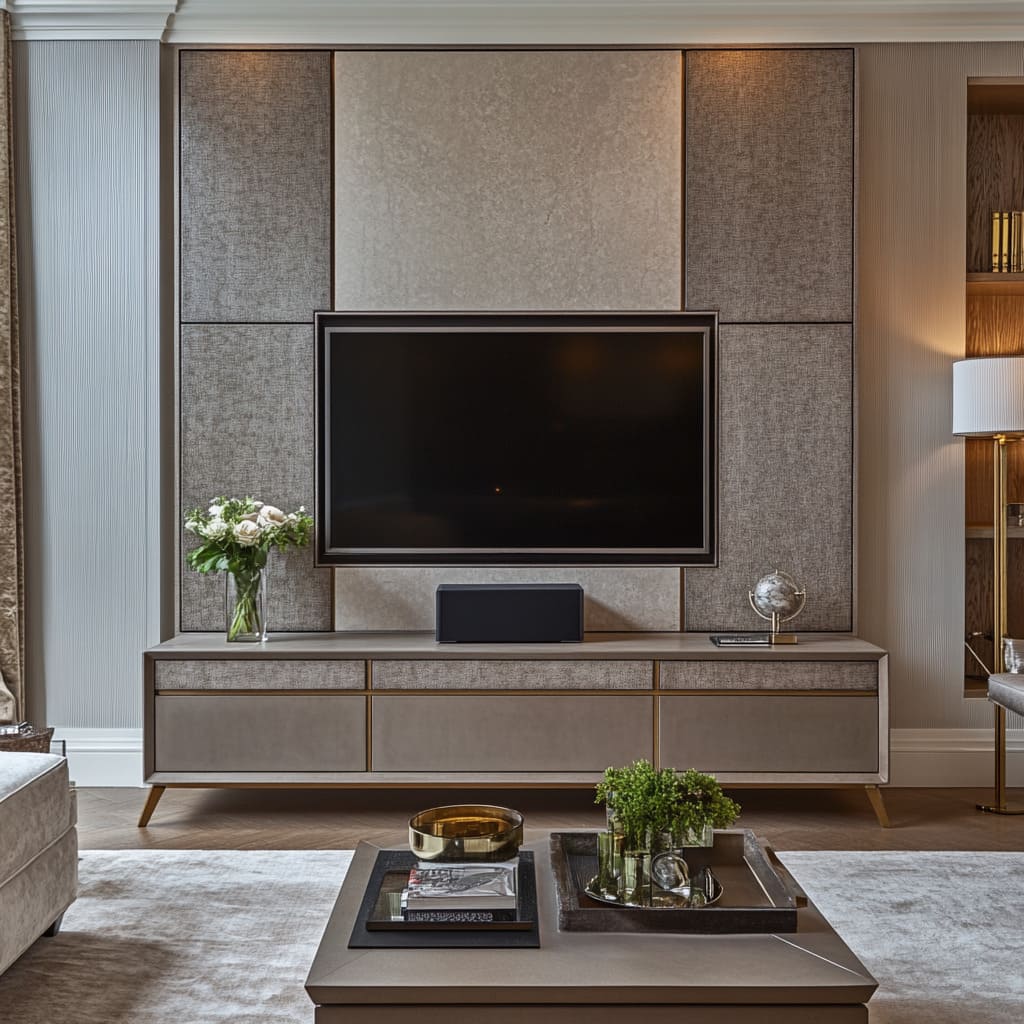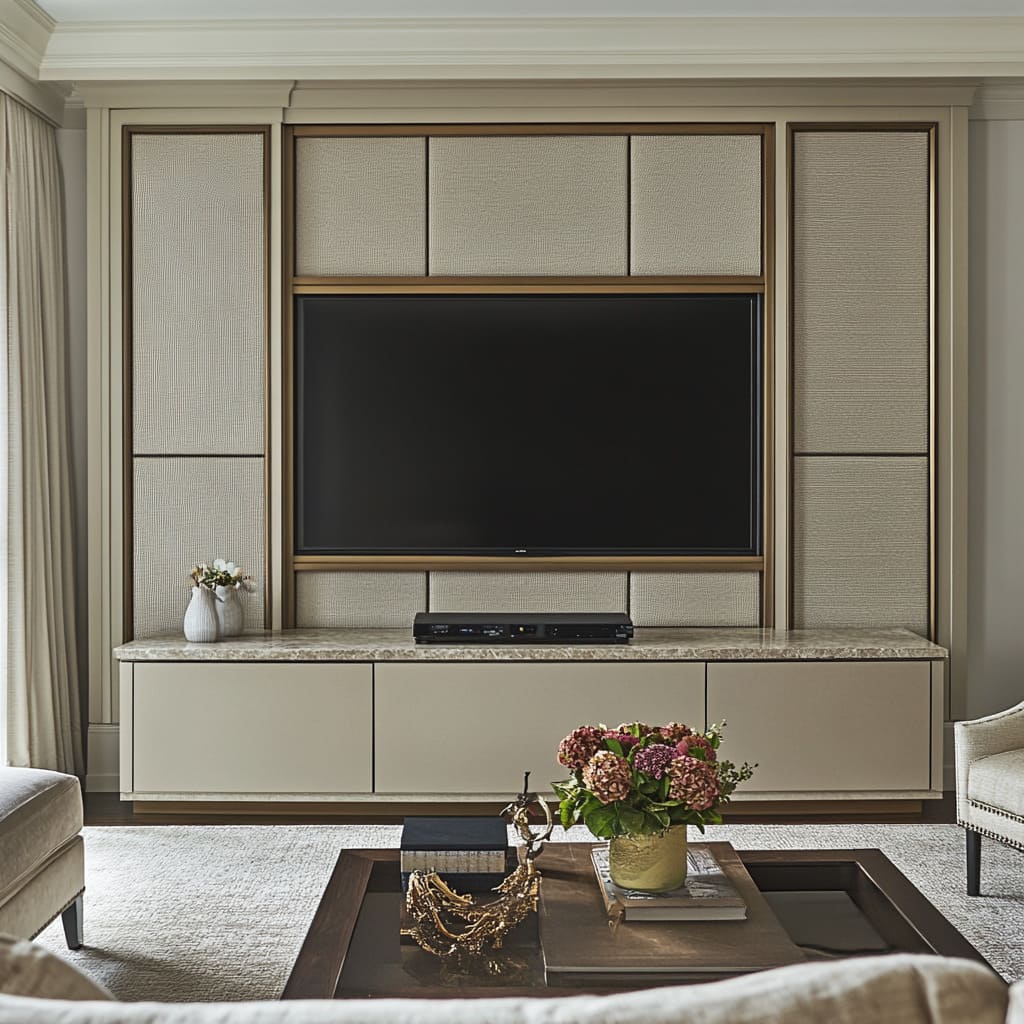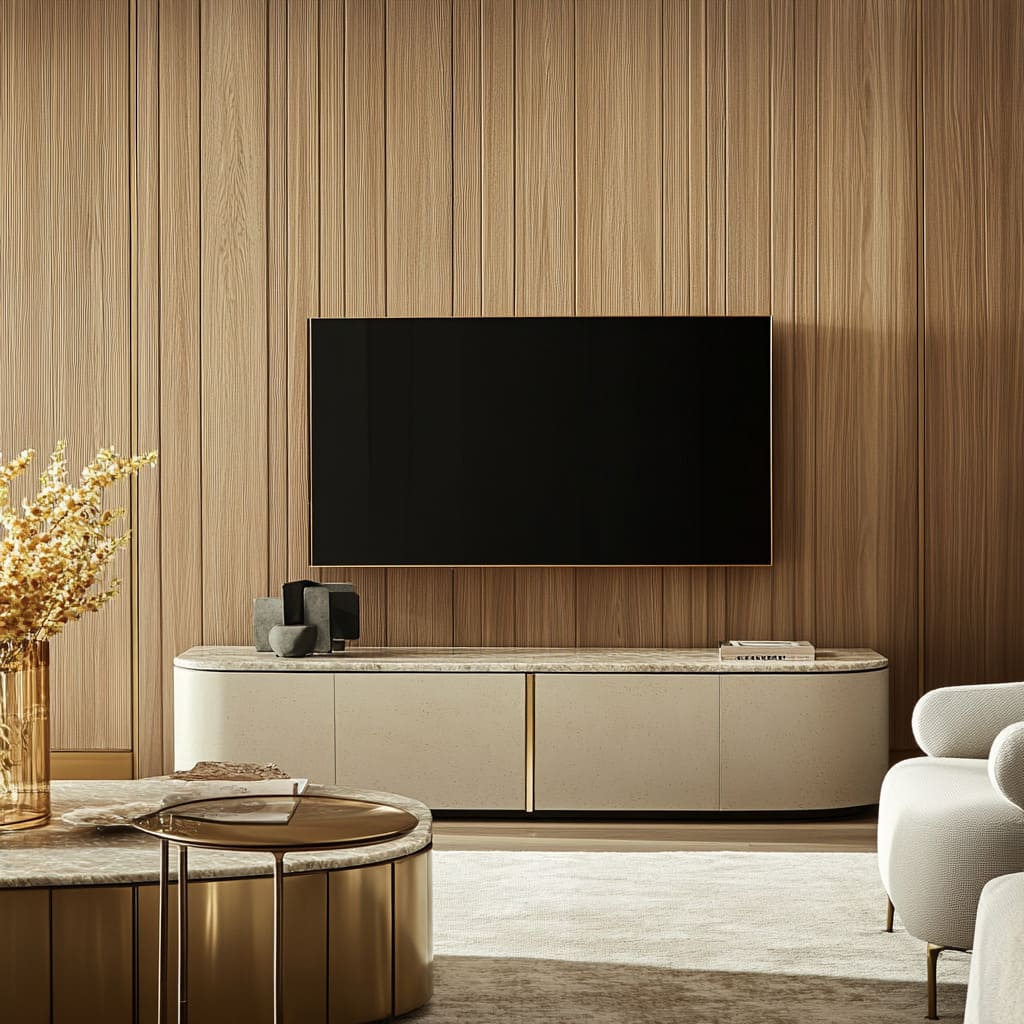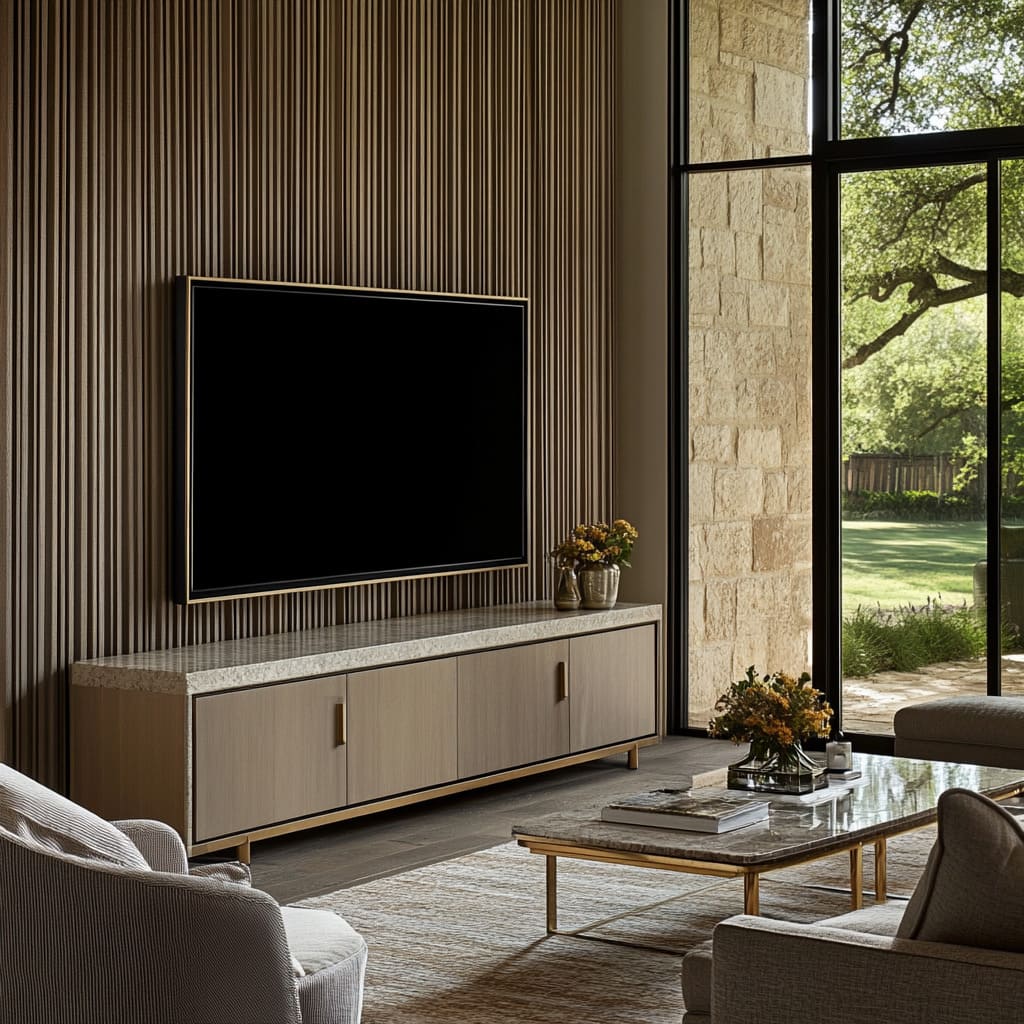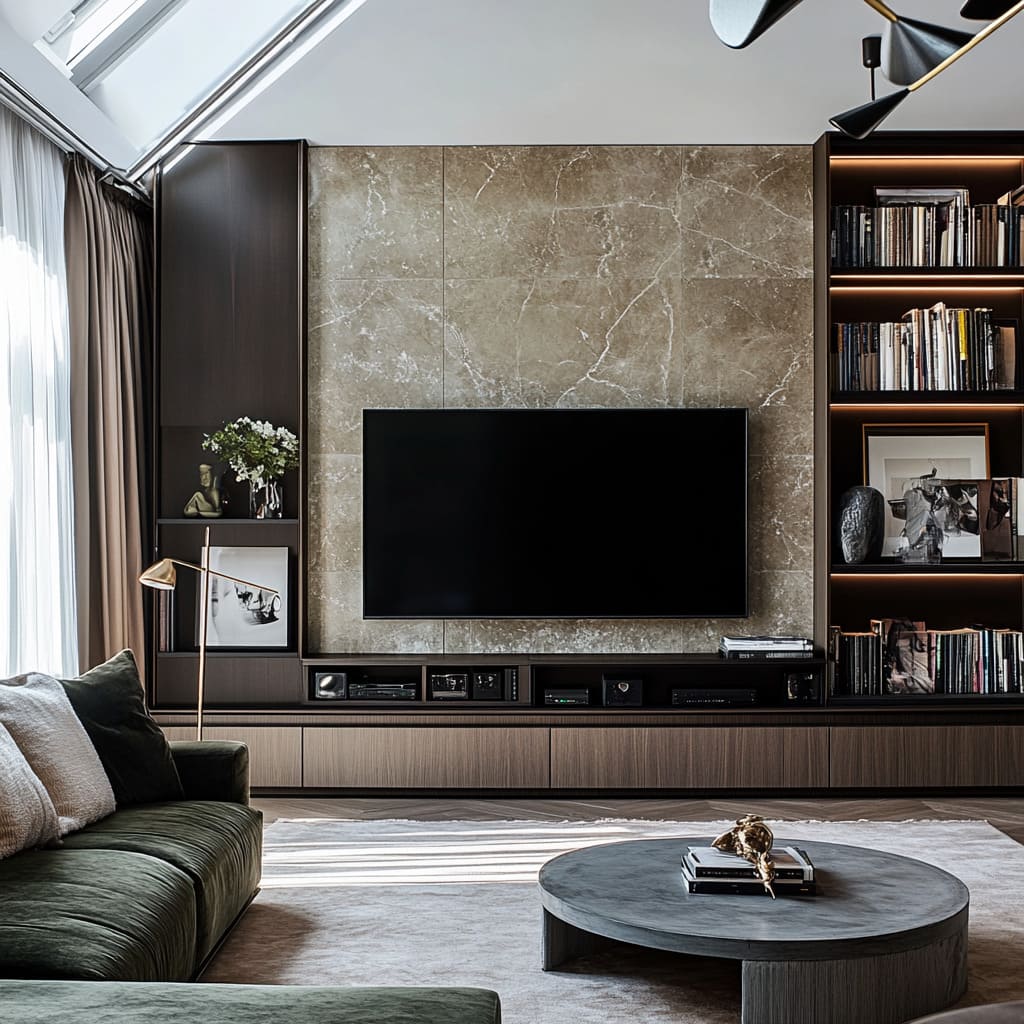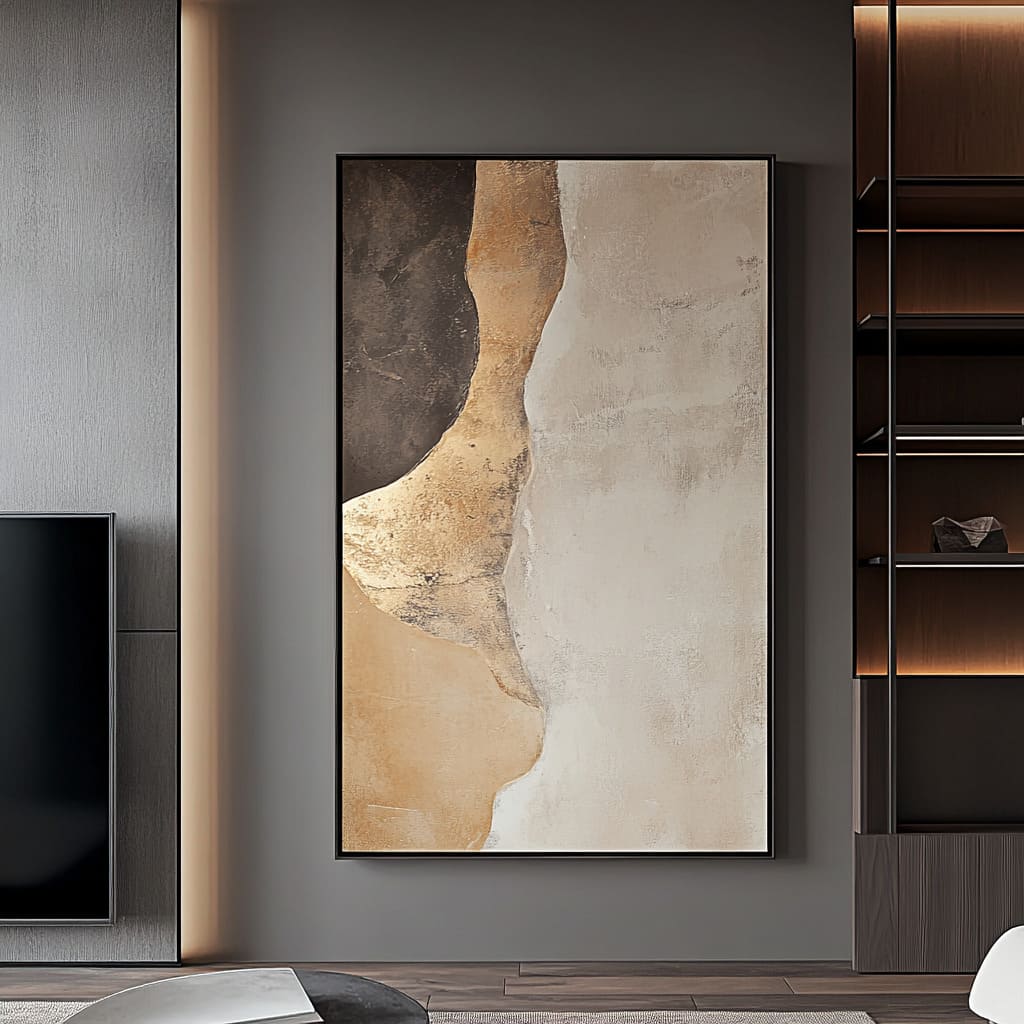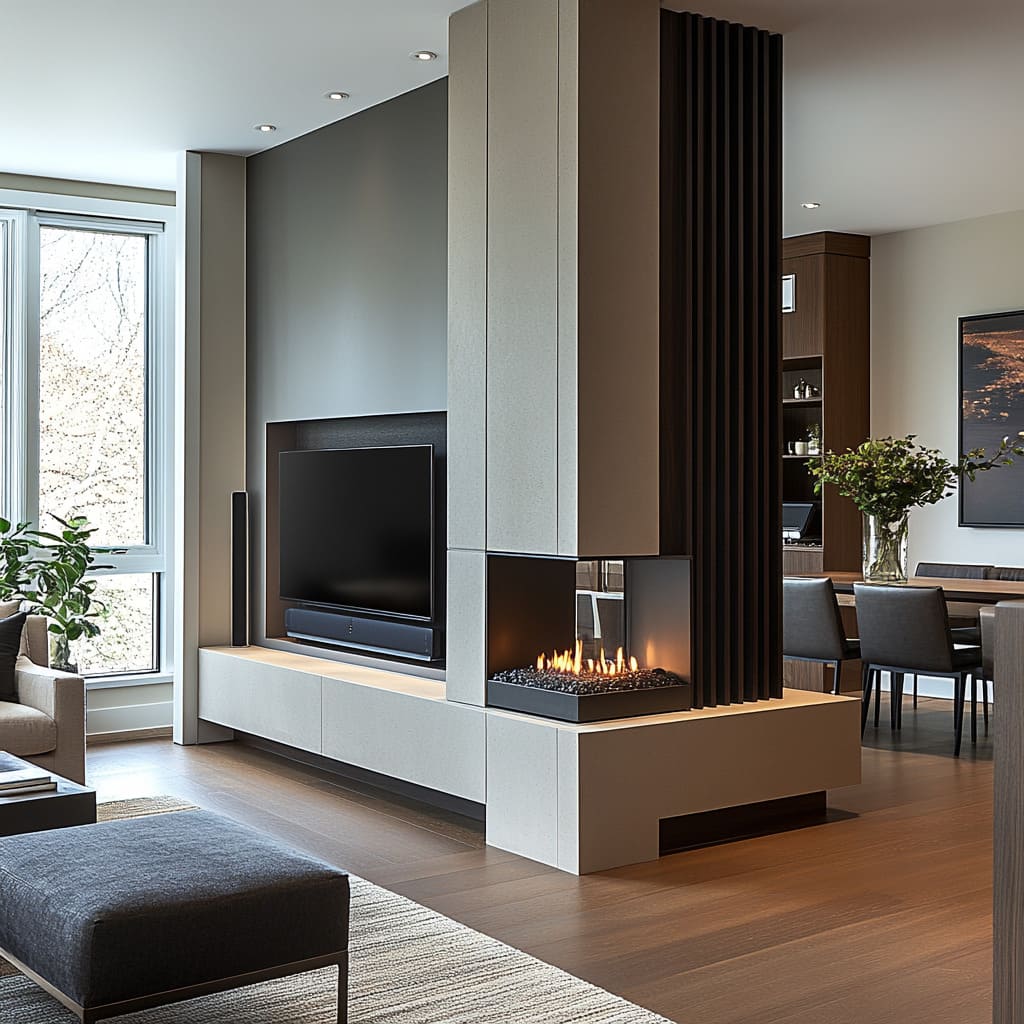Wall Panels: The Key to Elevating Modern Living Rooms
Textured and wooden Wall Panels as a Design Statement
Textured wall panels offer more than just an aesthetic update—they introduce depth and character into living spaces that flat walls can’t achieve. These panels are designed to bring a sense of refinement to the room, serving as both a visual and tactile element that enhances the atmosphere.
When you add texture, the walls become part of the room’s identity, moving beyond being a backdrop to truly shaping the feel of the space. Whether your choice is soft fabric, wood slats, or metallic accents, each material contributes a unique flavor to the room’s design.
For example, fabric-covered panels in shades of taupe, beige, or soft gray create an inviting foundation that pairs beautifully with modern technology, like flat-screen TVs. The soft texture of fabric introduces a warm, welcoming layer, making the room feel more comfortable and less stark, especially when integrated with minimalistic furniture.
This approach allows you to soften the impact of large electronics, creating a more balanced look. On the other hand, wood slats bring a sleek, modern edge to the design.
These vertical elements stretch the height of the room, giving the illusion of taller ceilings and more expansive space. This technique works well in modern and contemporary homes, where clean lines and natural materials take center stage.
Moreover, the use of wood in living rooms—whether it’s in dark walnut tones or lighter oak finishes—offers an organic quality that enhances the room’s visual appeal. Adding small metallic inlays to divide sections can introduce a layer of sophistication and make the TV wall the focal point of the room without feeling overbearing
This idea of using wall panels as a design feature isn’t limited to just one style. These panels can fit into both minimalist and luxurious environments, depending on how they are applied.
Whether you prefer a subtle, neutral backdrop or a bolder, high-contrast texture, the key is how you balance these materials with the rest of the room. The room’s textures, lighting, and furniture should all work in harmony to create an interior that feels complete.
Types of Wall Panels
When considering wall panels for your living room, the range of materials available can open up many design possibilities. Fabric panels, for instance, add a soft layer to the walls and help absorb sound, improving the room’s acoustics.
This makes them a popular choice for entertainment spaces where sound quality is important. The fabric adds a subtle richness that can either contrast with the clean lines of modern furniture or complement them, depending on the overall design.
Wood slats, on the other hand, are ideal for bringing in a natural element. Whether stained dark or left in their natural light grain, they can create an impactful visual effect, especially when arranged in vertical patterns. These slats also offer a great balance between visual interest and simplicity, making them an excellent choice for those who prefer a modern aesthetic but don’t want to sacrifice warmth.
If you’re looking for something more dramatic, metallic accents can elevate the wall’s appearance even further. Slim gold or brass lines between panels create a refined separation and introduce a subtle gleam that reflects light beautifully.
This material combination is particularly suited for living rooms with a minimalist base, as it adds a luxurious detail without feeling overwhelming. Metallic accents can also be paired with stone or concrete finishes for a more industrial, modern look.
The material choice should also consider how light interacts with the space. Wood slats and metallic elements can reflect both natural and artificial light, adding layers of depth to the room as the day progresses.
On the other hand, fabric panels absorb light more subtly, offering a calming effect that works well in spaces designed for relaxation. The versatility of these materials allows for a level of customization, making each room feel unique and thoughtfully designed.
The Impact of Vertical and Geometric Design
The design of the wall panels goes beyond the choice of material—it’s about how those materials are arranged. Vertical panels, for instance, are one of the most effective ways to visually expand a room.
By drawing the eye upwards, they create the impression of taller ceilings, which can make even smaller spaces feel more open and spacious. This verticality is particularly useful in rooms that feel confined, helping to elongate the space without requiring structural changes
Moreover, geometric patterns formed by panels add structure to the wall, providing a sense of order and clarity in the design. Dividing the wall into evenly spaced sections introduces a grid-like design that breaks up large surfaces into digestible visual elements.
The interplay between the materials and the geometric layout adds another layer of interest, ensuring the wall is far from flat or boring. The panels aren’t just placed to fill space—they guide the eye through the room, offering a focal point that’s dynamic yet understated.
This type of design also lends itself to customization. For example, adding lighting between the panel divisions can further emphasize the structure of the room.
Subtle LED lighting strips can enhance the texture and draw attention to the vertical lines, creating a soft glow around the TV unit that makes the entire wall feel more alive. The strategic use of light and shadow enhances the materials, making the room feel like a work of art rather than just a functional space
Sleek TV Units: The Perfect Balance of Style and Function
Minimalism in TV Units: A New Standard for Living Rooms
Modern TV units have evolved to become much more than just a place to hold your television. Sleek, low-profile designs are now a hallmark of contemporary living rooms, offering both functionality and a sense of refinement.
These units not only keep your media organized but also serve as an extension of the overall design, providing a seamless transition from technology to decor. One of the biggest advantages of modern TV units is their ability to conceal clutter.
With hidden compartments and sleek drawers, they keep cables, remotes, and devices neatly tucked away, allowing the room to maintain its clean lines. No more tangled wires disrupting the visual flow of the space.
Instead, the TV unit acts as a streamlined element that complements the textures and tones of the room. These units often feature luxurious finishes, such as matte surfaces or soft textures that mirror the wall panels above.
The use of metallic accents, particularly in subtle gold or brass, adds a touch of warmth and sophistication. The combination of functionality and aesthetics means you don’t have to choose between a stylish living room and a practical one—you can have both
Materials and Finishes for TV Units
The material and finish of a TV unit can significantly affect the overall vibe of the room. Matte finishes in soft taupe or beige are excellent choices for those looking for a subtle, understated elegance.
These neutral tones blend seamlessly with the wall panels, creating a cohesive design that feels effortless. The matte finish also provides a soft contrast to the sleek screen of the television, balancing the various textures in the room.
For those wanting a bit more flair, metallic trims can make all the difference. A hint of gold or brass along the edges of the unit adds a luxurious touch without overpowering the minimalist aesthetic.
These metallic elements work well in both small and large spaces, offering a way to introduce warmth into the room’s design. They also pair beautifully with other metallic accents in the decor, ensuring the space feels unified and thoughtfully composed.
Another popular choice is stone or marble finishes for the surface of the TV unit. These materials introduce an earthy element that can complement wood or fabric wall panels.
The smooth surface of stone contrasts nicely with the textured walls, offering another layer of depth to the room’s overall design. Whether you choose a light marble or a darker stone, these materials provide durability and a refined look that elevates the living room’s aesthetic
Bringing It All Together: Creating a Cohesive Aesthetic
Balancing Functionality and Aesthetics
When it comes to modern living room design, balancing form and function is key. Integrating technology into your space without sacrificing style can be a challenge, but when done well, it transforms the room into a space that’s both beautiful and functional.
Wall panels and sleek TV units work together to achieve this balance, creating a harmonious environment where technology is seamlessly incorporated into the overall design. Textured wall panels help soften the impact of large flat-screen TVs, ensuring that the room doesn’t feel dominated by technology.
The TV becomes part of the design, rather than the centerpiece, allowing the eye to focus on other elements in the room, like the textures, finishes, and carefully curated decor. This balance between functionality and aesthetic appeal is what defines modern living rooms today.
By choosing materials and designs that complement one another, you can create a cohesive aesthetic that feels polished yet comfortable. Whether through the use of vertical wall panels, sleek TV units, or carefully chosen materials, the key is to ensure every element works together to create a unified, stylish space.
Types of Wall Panels: Materials That Make a Difference
The material you choose for your wall panels can dramatically shift the atmosphere of your living room, influencing both the look and feel of the space. From plush fabric to solid wood, each option has its own unique way of elevating the overall design.
While fabric-covered panels can soften a room and absorb sound, wooden panels offer a completely different kind of impact. With their natural texture and warmth, wooden panels introduce a rich, tactile element that instantly elevates the room’s character
One of the most versatile options in modern design is wood panels made from solid oak or veneer finishes. These panels allow you to create a striking yet natural aesthetic that’s perfect for both contemporary and traditional interiors.
Solid oak panels, in particular, offer durability and a timeless appeal that many homeowners seek when designing a space that will last. The rich grain of oak, whether it’s in a lighter finish like white oak or a deeper, more dramatic tone like smoked oak, brings out the inherent beauty of the wood.
The natural imperfections in the grain add texture and depth, making each panel feel unique. When choosing solid oak for wall panels, you’re introducing an element that will naturally evolve over time.
The wood develops a patina as it ages, becoming richer in character and creating an environment that feels warm and inviting. Solid oak panels are also excellent for rooms where you want to establish a sense of grounding—something that feels both permanent and sturdy.
Paired with other minimalist features in the room, these panels can be a stunning focal point that speaks to quality and craftsmanship
For a more flexible and cost-effective alternative, wood veneer panels offer the beauty of natural wood with a sleeker profile. Veneers are thin slices of wood applied over a substrate, giving the look of solid wood without the heavier weight or cost.
One of the biggest advantages of veneer is that it allows for more intricate designs, including wood patterns that might be difficult or costly to achieve with solid wood. For example, veneers can be cut and arranged in herringbone, chevron, or linear patterns, giving the room an architectural sophistication that adds another layer to the design.
The choice between solid wood and veneer depends largely on the design goals for the space. Solid wood panels provide more texture and natural variation, while veneers offer consistency and flexibility in terms of design.
Both options can be stained or finished in a variety of tones—from natural oak hues to deep, dramatic stains that bring out the grain patterns. Whether you choose to keep the wood natural or opt for a darker stain, the beauty of wood lies in its ability to complement almost any color palette or style.
Wooden panels, whether they’re made of solid oak or veneer, also interact beautifully with lighting. As light shifts throughout the day, it reflects off the natural grain, creating subtle highlights and shadows that bring the walls to life.
In rooms where natural light is abundant, wood’s reflective quality can warm the space in the morning and deepen in richness as the day progresses. Even under artificial lighting, the grain of the wood offers a dynamic visual element, making the wall feel alive and part of the room’s evolving atmosphere
Combining wood panels with other materials such as metal or fabric can further enhance the depth and complexity of the design. For example, pairing oak wood with slim brass or bronze inlays between panels introduces a contemporary touch, while still maintaining the organic feel of the wood.
Similarly, combining wooden panels with fabric sections can soften the overall look, ensuring the room doesn’t feel too rigid or formal. The wood panels act as a strong, grounding element, while the fabric adds warmth and texture to balance the design.
In terms of placement, wood panels are not limited to just one wall. They can be used as an accent behind the TV or extended to wrap around the room, creating a unified and cohesive look.
In larger rooms, wooden panels can help break up the space, introducing zones of interest without overwhelming the room. For smaller spaces, vertical wood slats can make the ceiling appear higher, creating a sense of openness that is especially beneficial in compact living areas.
The versatility of wood panels makes them an ideal choice for anyone looking to introduce natural elements into their living room. Whether used sparingly or as a dominant feature, wood’s warmth and texture bring an organic quality that resonates with modern design trends focused on creating spaces that feel both luxurious and lived-in.
Ultimately, choosing wooden wall panels—whether solid oak or wood veneer—allows you to craft a space that speaks to timeless elegance and modern simplicity. With the right finish, wood can transition between different styles, adapting to various moods and settings, while maintaining its natural beauty.
When integrated thoughtfully, these panels don’t just change the look of the room; they redefine how the space feels, creating a living room that invites comfort and sophistication in equal measure
The Impact of Vertical and Geometric Design
Why Vertical Lines Make Your Space Feel Expansive
Incorporating vertical lines and geometric patterns into wall panel designs is one of the most effective ways to introduce a sense of height and spaciousness to a living room. These designs naturally guide the eye upward, creating an illusion of higher ceilings, which is especially beneficial in rooms with limited vertical space or smaller overall dimensions.
The simple act of adding vertical panels or grid-style divisions can dramatically alter the perception of a room, making it feel open and expansive. Vertical panels are often seen as a solution for rooms with low ceilings because they provide a visual stretch.
In homes where ceilings are lower, there’s often a desire to create a more airy, open feel, and vertical paneling achieves this by drawing attention to the full height of the room. This upward emphasis elongates the walls, allowing the room to feel taller than it actually is.
Similarly, these vertical lines can also make large, open-plan living rooms feel more structured by introducing subtle boundaries that define different zones without needing to erect walls
But verticality isn’t limited to just height enhancement. When panels are arranged in grid-like patterns or with clear geometric divisions, they not only provide structure but also introduce a sense of order and precision to the room.
The grid design breaks up larger walls into smaller, digestible sections that balance the space without overwhelming it. This geometric approach gives a room an architectural quality, helping it stand out while still maintaining a clean, minimalist look.
For instance, imagine a living room where the TV wall is lined with sleek, vertical wooden slats divided by metallic accents. The combination of vertical lines and reflective inlays not only makes the room feel taller, but the play of light and shadow across the structured surfaces adds depth and texture.
Even with minimal decor, these panels become an art form in their own right, offering a sophisticated visual feature that doesn’t need to rely on heavy ornamentation
The interplay between light and shadow on these vertical or geometric panels is key to enhancing the room’s depth. As natural light changes throughout the day, or as artificial lighting hits the surface from different angles, the panels come to life.
In the morning, sunlight may gently emphasize the grain of wooden slats, while in the evening, soft ambient lighting might cast subtle shadows that make the metallic accents glimmer. This dynamic relationship with light makes the walls feel more alive, giving the room a sense of motion and dimensionality that evolves as the day progresses.
Geometric patterns offer even more opportunities for creativity. By arranging panels in a grid-like fashion, you can create a strong sense of structure that contrasts beautifully with the softness of other design elements in the room, such as textiles or upholstery.
These patterns can be uniform, or they can play with scale—larger grids for dramatic effect or smaller ones for a more subtle approach. The beauty of geometric paneling lies in its versatility, allowing you to create bold statements or more understated sophistication depending on the scale and spacing of the patterns
When combined with other elements in the living room—whether it’s a sleek, modern TV unit or carefully chosen decor—vertical and geometric panels serve as the foundation of the room’s design. These panels help tie everything together by providing a cohesive framework that supports the rest of the interior.
The room feels more balanced and harmonious, regardless of the overall size or layout, because the walls offer a consistent, organized rhythm that flows throughout the space. Even in minimalist designs, where less is often more, the impact of vertical and geometric wall panels cannot be understated.
Their ability to add both height and structure, while also interacting with light and shadow, makes them one of the most powerful design tools for transforming a living room. These elements don’t just add style; they redefine how the space feels, turning even the simplest room into one that’s rich in detail and full of life.
Creating a Focal Point with Wall Panels
Turning Functional Walls into Art Pieces
One of the most powerful ways wall panels are transforming living rooms is by elevating the TV wall from a purely functional element to a striking design feature. In many modern homes, the TV wall has become the centerpiece of the living room.
But rather than allowing the TV to overwhelm the space, well-designed wall panels can balance its presence, turning the wall into an artistic focal point that enhances the overall room’s ambiance. Traditionally, the TV is a dominant feature in the living room—large, dark, and often visually heavy.
However, wall panels provide a way to integrate the TV into the space seamlessly, making it part of a larger design narrative rather than a singular attention-grabber. A carefully considered panel design can frame the television in such a way that it feels intentional, as though it was always meant to be there.
By doing this, the wall becomes a canvas where technology and aesthetics coexist beautifully
For instance, fabric-covered panels in soft, neutral tones, such as taupe or light gray, can act as a subtle and calming backdrop for the TV. These panels soften the impact of the television by blending it into the overall design rather than letting it stand out as a large black rectangle on an otherwise blank wall.
The fabric introduces texture that contrasts against the sleek, flat surface of the TV, creating a balance between the technological and the organic. This helps the TV feel less intrusive, allowing the wall to play an important part in the room’s visual composition rather than just being a surface to mount the screen.
Wooden panels, especially those with vertical slats, can also create an impressive backdrop for a TV. When paired with darker screens, the natural grain and warmth of the wood provide a strong visual contrast, making the wall feel dynamic without overshadowing the other design elements in the room.
The vertical slats, in particular, draw the eye upward, creating a sense of height and enhancing the feeling of openness in the space. This layering of textures and tones frames the TV in a way that complements the room’s architecture, ensuring that it fits harmoniously into the overall design scheme
For those who seek a more luxurious touch, metallic trims or accents incorporated into the wall panels provide an elegant way to frame the TV. Slim strips of brass or gold between panels can outline the television area, subtly drawing attention to the screen while maintaining a polished, high-end look.
These metallic details add a hint of glamour without overpowering the simplicity of the panels, keeping the room’s design cohesive and balanced. Metallic trims serve to highlight the TV in a way that feels deliberate and stylish, creating a seamless connection between the technology and the luxurious materials used throughout the space.
The beauty of wall panels as a focal point is that they don’t just serve the TV—they also create a gallery-like atmosphere for other decorative elements. Surrounding the TV with panels offers opportunities to integrate lighting, artwork, or shelving in a way that complements the central focus.
For example, recessed LED lighting can be installed behind the panels, adding a soft glow around the TV and enhancing the wall’s textures. This subtle lighting effect elevates the design, creating a sense of depth and drama that would be difficult to achieve with a simple, flat wall.
In addition, the interplay of materials and textures used on the TV wall allows you to introduce other decorative pieces without overwhelming the design. Whether you want to place small sculptures, curated decor, or personal items on shelves integrated into the wall paneling, these elements can be introduced thoughtfully, ensuring that the room remains both functional and aesthetically pleasing.
The wall’s ability to serve as both a functional surface and a design centerpiece makes it one of the most versatile elements in modern living room interiors
By turning the TV wall into a multifaceted design feature, you transform the living room into a space that feels purposeful and intentional. Instead of a large, plain surface dominated by a screen, you now have a wall that offers texture, contrast, and depth, becoming an engaging focal point.
Whether through fabric, wood, or metallic accents, wall panels elevate the entire room, ensuring that the TV no longer feels like an afterthought but rather an integral part of a beautifully designed space. In today’s living rooms, where technology and design intersect, the TV wall is no longer just about function—it’s about creating a statement that resonates with the rest of the room’s aesthetics.
By carefully selecting materials and incorporating thoughtful design details, you can turn this often-overlooked feature into the defining element of your space, one that showcases both your style and your creativity
Blending TV Units with Decor
Decor That Elevates Without Cluttering
Sleek TV units are not only functional and stylish on their own, but they also provide a beautiful platform for displaying decor that enhances your living room without overwhelming the minimalist aesthetic. The clean lines of modern TV units create the perfect backdrop for decor, offering a subtle stage that lets personal touches shine.
When used thoughtfully, these surfaces become opportunities to add warmth and personality to the room while maintaining the overall sense of balance and simplicity. One of the most effective ways to decorate a TV unit is by choosing small, well-curated items that reflect your personal style without creating unnecessary clutter.
For example, a small vase filled with fresh flowers can bring a touch of nature and vibrancy to the room. The soft greenery and bright blooms introduce an organic element that contrasts beautifully with the sleek surfaces of the TV unit and the wall panels behind it.
Placing a single vase on one side of the console keeps things minimal yet intentional, ensuring that the decor feels deliberate rather than haphazard
Decorative objects in metallic finishes, such as brass or silver, can add a subtle yet luxurious touch to your TV unit. A small metallic sculpture or a decorative bowl can break up the linear nature of the unit and introduce a touch of artistry.
These pieces serve as accents that reflect light and bring attention to the surface of the console without competing with the TV or other design elements in the room. For instance, a polished brass sculpture placed alongside a matte finish TV unit adds visual contrast and a hint of opulence while staying true to the minimalist theme.
Books are another great addition to the decor on your TV unit, especially when chosen with care. A few well-selected coffee table books can be stacked neatly on one end of the console, bringing in a sense of intellectual warmth and color without creating too much visual noise.
The spines of the books can either introduce a subtle color palette that complements the room, or remain neutral for a more understated look. These books don’t just serve as decoration—they add depth to the room by showcasing interests and personal taste, giving the space a lived-in, curated feel
In terms of arrangement, symmetry can help keep the decor from feeling cluttered. For example, placing a vase of flowers on one end of the unit and balancing it with a stack of books or a decorative item on the opposite side creates harmony.
This balanced approach allows each piece to stand out on its own while still contributing to the overall flow of the room. Even when using asymmetry, it’s important to keep the decor minimal, so that the sleek design of the TV unit remains the main focus.
When adding decor to a TV unit, it’s important to avoid overcrowding the surface. Minimalism thrives on clean spaces and a sense of order, so leaving some empty areas on the console is essential.
Instead of filling every inch with items, allow negative space to play a role in the design, giving each piece room to breathe. This approach not only keeps the unit looking sleek but also enhances the impact of the decor that’s on display
For homes that embrace modern, neutral tones, a few accent pieces with contrasting textures or materials can bring in much-needed depth. For example, if your TV unit features matte finishes, adding a glass vase or ceramic bowl can provide a complementary contrast.
The mix of textures makes the overall design feel more dynamic and layered, even within the minimalist framework. The contrast between smooth surfaces and textured decor introduces complexity without disrupting the clean lines of the room.
Lighting can also play a significant role in highlighting the decor on your TV unit. Subtle lighting, such as small LED strips beneath the console or ambient light from nearby floor lamps, can help draw attention to the carefully chosen items.
Soft lighting creates highlights and shadows that bring out the textures of the materials, whether it’s the reflective surface of a metallic sculpture or the matte spine of a coffee table book. This interplay between light and decor makes the unit feel like an integrated part of the room’s overall design, rather than just a functional surface
One thing to keep in mind when decorating sleek TV units is the importance of keeping the space practical. While it’s tempting to fill the console with decorative items, it’s essential to leave room for everyday functionality.
Remote controls, gaming devices, or media players need space too. The beauty of modern TV units is that they balance aesthetics with practicality.
With smart storage solutions built into the design, you can hide away those less attractive everyday items while still leaving room for decor that enhances the room’s beauty
Ultimately, decorating sleek TV units is about finding the perfect balance between personality and simplicity. By selecting a few carefully chosen items, you can elevate the room’s aesthetic without cluttering the space.
Whether you opt for fresh flowers, metallic accents, or curated books, the key is to let the clean lines of the TV unit shine while using decor to add warmth and character. This thoughtful approach ensures that the unit remains functional yet stylish, fitting seamlessly into your modern living room.
